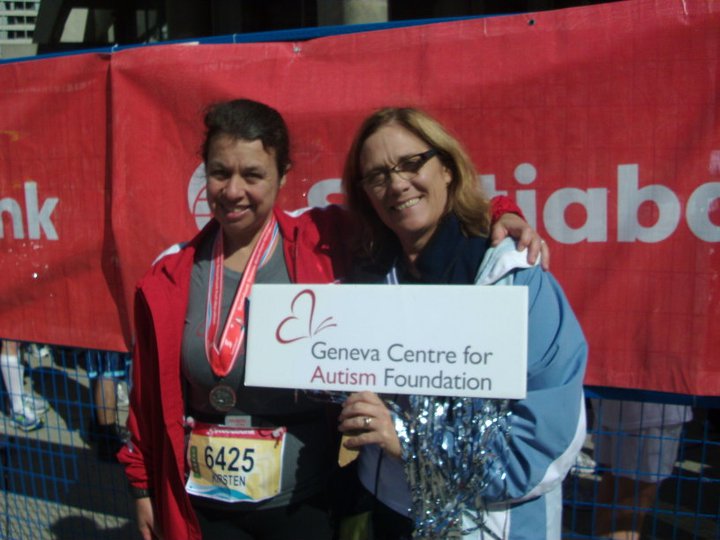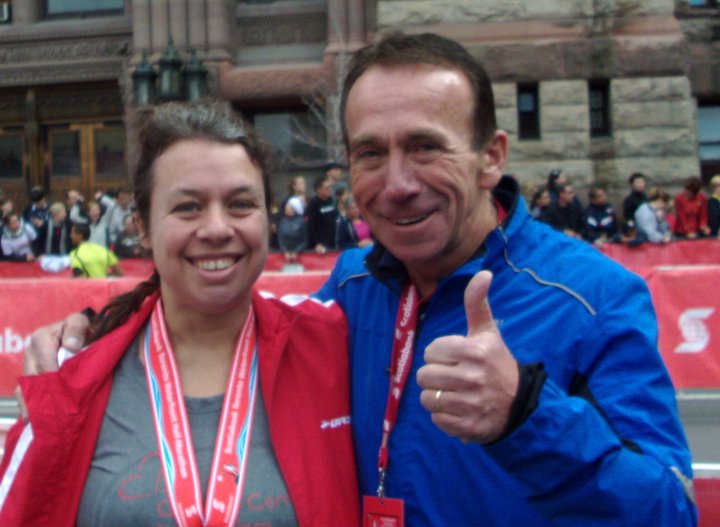A decade ago, when I was training for my first-ever race (a 5K, if memory serves), my Dad taught me how to fish for runners. You start at an easy pace, he said, and you don’t allow yourself to be deterred by the hordes of people passing you. When you pass the halfway mark, you pick a target: a runner far ahead of you who you can set your sights on. You gradually reel in the runner and eventually pass them. And then you pick a new victim to fish for, and you keep doing this until you have about five hundred meters to go, at which point you just go hell-for-leather until you cross the finish line.
In his prime, my Dad was one of the top marathoners – and for a time, ultramarathoners – in South Africa. I had a great deal of respect for the running advice he gave me. I used the technique of fishing for runners in my first half-marathon, back in 2001, and it worked like a charm.
Dad was my unofficial coach. Even though he lived on the other side of the world, he was always giving me snippets of advice that ranged from, “Shorten your stride and keep a straight posture going up hills” to, “Bring your own toilet paper to races because the portajohns tend to run out”. He taught me that hydrating in short, frequent bursts is better than gulping down sixteen ounces of water every five kilometres. He took one look at me after the one race he saw me in (a 10K in North York) – he saw the fine layer of salt covering my skin and turning my clothes white – and told me to ditch Gatorade and get a better electrolyte source. He taught me how to shop for running shoes, and explained why good socks are almost as vital as good shoes.
By the time I returned to running after a seven-year gap, Dad was no longer with us. When I was out on my Sunday long runs, and when I was running my first half-marathon in eight years in considerably less than stellar shape, I had to rely on memories of what Dad had told me. I missed him bitterly on the day of my first Run for Autism, just over a year ago. I did not get to call him for a pre-race pep talk. I was not able to imagine talking to him on the phone later, going through a post-mortem of the race. I was so anxious about simply finishing the race that I found following any kind of a strategy difficult. I knew, however, that he would be immensely proud of me, and that was enough.
Throughout this running season that is just drawing to a close, I have felt Dad’s presence from time to time. I have remembered more and more of what he told me, and I have read through his old training logs for tips and ideas, and for general inspiration. And then, on Saturday, something weird happened.
I was registered for a 10K run at the zoo. Initially, I wasn’t even sure if I would be able to run it: it was just three weeks after a half-marathon that left me walking funny for days. I had not really gotten back into proper training since the half-marathon, and I figured that this would be a problem because there are a lot of hills at the zoo. So I went in with absolutely no expectations of myself. My plan was to just finish the run and enjoy myself.
About two kilometres into the run, I found myself getting frustrated by slower runners ahead of me. The road was just too narrow for me to pass them; I was waiting for an opportunity to slip by them and surge ahead. All of a sudden I heard Dad’s voice in my head: “What’s the rush?”
“It’s a race,” I pointed out (in my head, of course. I haven’t quite reached the point of conversing with my deceased father out loud).
“Sure, it’s a race,” said the voice of Dad’s wisdom, “but you have 8K to go. You’ll get your chance a couple of kilometres from now, when the runners are more spread out.”
“But I feel good,” I argued. “I want to go faster.”
“Trust me. You’ll thank me for this later.”
I briefly debated whether to listen to my own actual voice, or the imagined voice of a man who passed away almost six years ago. Imagined voice, I decided. If there is an afterlife, and if Dad is making the effort to coach me during a race from the Beyond, the least I can do is listen and give it a try.
I approached the first hill of the run, and thought, “Uh oh.” From way back in the past, Dad’s hill mantra came back to me. “Shorten your stride. Keep your spine straight. Focus your vision on the crest of the hill.” Because I followed the mantra, and because I hadn’t burned off all my energy five hundred metres previously by barrelling past the slower runners, I made it to the top of the hill without even slowing my pace. As it turned out, I passed a number of runners going up the hill. “Thanks Dad,” I said mentally. “Told you so,” he replied.
Before I knew it, I was running over the timing mats at the halfway point. I was feeling good and enjoying the scenery. Suddenly, Dad was back, as if he’d just popped off to see the lions. “Speed up,” he said. “Where do you think you are, a picnic?”
“Cripes, Dad, you were just telling me there was no rush,” I grumbled.
“That was then,” he said, cryptically. “It’s time to fish.”
I looked up and scanned the runners ahead of me. “The one with ears,” said Dad. This would have startled me if I hadn’t seen, just in my range of vision, a runner wearing a pair of rabbit ears on his head (one thing about a run at the zoo is that people get creative about what they’re wearing).
Rabbit Ears turned out to be the perfect point of focus for me. By now, the runners were spread out enough for me to pass without impediment. I picked up the pace and bit by bit, I closed in on Rabbit Ears. When he slowed for a drink at the water station, I zoomed on past (another bit of advice from Dad: always take your own water to a race to reduce the number of times you have to slow down at an aid station).
My next victim was a woman wearing a bright red shirt boasting the words, “Toenails are for sissies”. Once I got past her, I set my sights on a man with some kind of turban on his head, followed by a man wearing a pair of butterfly wings. Throughout all of this, my legs were feeling strong, I was enjoying every step of the run, and I was running up and down the hills with not a care in the world. With five hundred metres to go, Dad had one last piece of advice: “Pretend they’ve let the lions out after you.”
I pretended the lions were after me, and sprinted to the end. I crossed the finish line feeling strong. I missed my personal best time for the distance by about a minute, and I was OK with that. My personal best was set on an all-downhill course; I performed a lot better here at the zoo and felt stronger at the end. From the perspective of pacing, race strategy, and running mechanics, this was my best race since my return to running.
Thanks, Dad!











